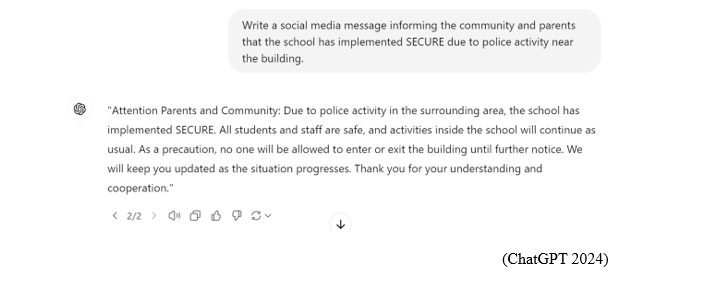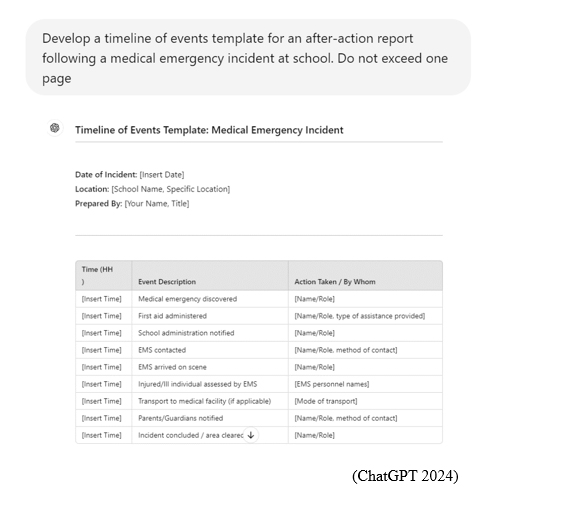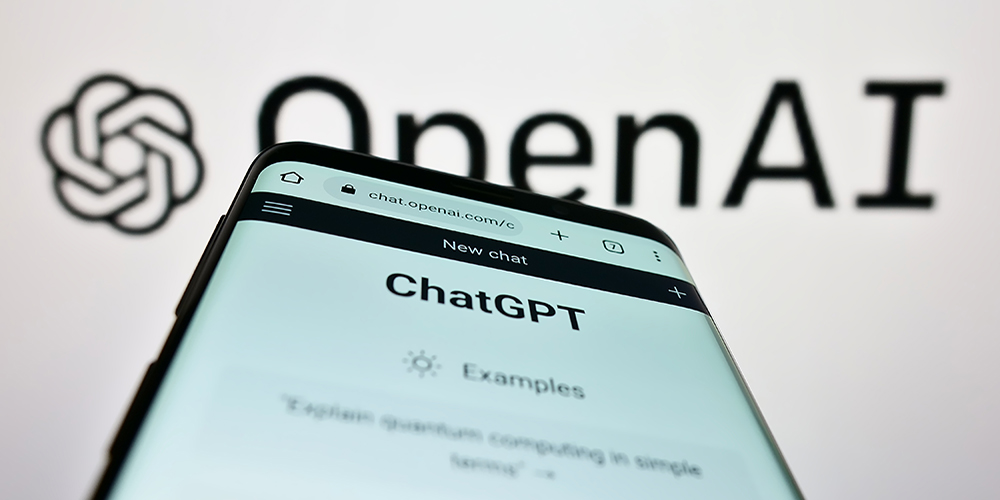The increasing complexity of school safety challenges has led educators, administrators, and public safety professionals to seek innovative solutions that can enhance preparedness, response, and recovery efforts. Over 90% of public schools nationwide have written emergency plans, and traditionally, school safety planning relies on well-established protocols, comprehensive training, and collaborative relationships between schools and local emergency services.
However, the rapid advancement of artificial intelligence (AI) technologies, particularly AI-driven language models like ChatGPT, Claude, and others, presents a new opportunity for school safety stakeholders to transform these efforts. AI tools excel in processing vast amounts of information, providing real-time communication support, and generating tailored responses. They offer significant potential in addressing the dynamic and unpredictable nature of school emergencies.
The utilization of AI continues to be a growing trend. A 2024 study by National University revealed that 77% of companies currently use or explore AI in their business plans. Leveraging AI in school safety extends beyond predictive analytics or automated alerts; it includes optimizing emergency communication, enhancing decision-making during crises, and supporting recovery efforts post-incident.
RELATED ARTICLE: Enhancing School Bus Safety with AI: Protecting Students on the Road and Beyond
AI platforms can serve as versatile tools for school administrators, enabling the drafting of emergency plans, coordinating responses, and assisting in disseminating critical information to staff, students, and parents. These systems also have the potential to address long-term recovery needs by providing resources and facilitating debriefing processes.
This article explores how AI technologies can be integrated into a comprehensive school safety strategy. By examining the specific applications of AI before, during, and after emergencies, we will highlight the unique advantages these tools bring to the evolving landscape of school safety management. The discussion will center on how AI can enhance human decision-making, streamline communication, and improve the overall resilience of school communities during emergencies.
Using AI Before a School Emergency
- Crisis Communication Planning:
- Drafting Emergency Plans and Policies: AI can assist in crafting or refining emergency response plans, communication templates, and safety policies. It can aid in developing standard operating procedures (SOPs) for various scenarios, such as lockdowns and evacuations.
- Parent & Staff Communications: AI can draft templated emails, letters, or text messages that clearly communicate safety protocols or drill schedules to parents, staff, and the broader community.
- Training Content Development: Administrators can use AI to create customized training materials, such as quizzes, role-playing scripts, or lesson plans, to educate staff and students about emergency preparedness.
- Scenario Development for Drills & Tabletop Exercises:
- Creating Realistic Emergency Scenarios: AI can generate complex, realistic scenarios for tabletop exercises or drills, including natural disasters, active shooter situations, or other emergencies. This allows administrators to test response protocols effectively.
- Customizing Exercises for Specific Schools: Based on school-specific details, AI can tailor scenarios to address the unique needs of a school’s geography, population, or resources, ensuring a more relevant and effective practice.
- Pre-Event FAQ Generation:
- FAQ and Information Guides: AI can create FAQs or information packets for parents and students, answering common questions about emergency procedures and preparedness efforts. This ensures consistent communication and reduces confusion during an emergency.
RELATED ARTICLE: CISA Releases K-12 School Physical Security Guide for School Business Officials
Using AI During a School Emergency
- Crisis Communication Support:
- Real-Time Messaging: During an emergency, administrators can leverage AI to help draft and disseminate real-time updates to staff, parents, and students. AI can quickly produce clear, concise alerts based on the unfolding situation, ensuring that stakeholders are informed.
- Decision-Making Assistance:
- Advice on Best Practices: AI can advise administrators on emergency management best practices, offering suggestions on evacuation procedures, communication priorities, or immediate steps to safeguard students and staff.
- Summarizing Information: In times of emergency, AI can assist administrators in quickly summarizing incoming information from various sources, enabling better decision-making without being overwhelmed by data.
- Staff Coordination:
- Real-Time Instructions: Administrators can use AI to draft and relay step-by-step instructions to teachers and staff, keeping everyone aligned during emergency response efforts. For example, it can assist in crafting guidance for teachers on lockdown protocols or evacuation routes for specific incidents.
- Handling Incoming Queries: During the crisis, administrators may receive numerous questions from staff, media, or first responders. AI can help answer these in real time, allowing administrators to focus on immediate safety issues. Below is an example of a prompt given to ChatGPT:

RELATED ARTICLE: 7 Ways Superintendents and Principals Can Effectively Lead During a School Crisis
Using AI After a School Emergency
- Debriefing & Incident Reports:
- Drafting Incident Reports: After an emergency, administrators can use AI to help compile detailed incident reports, documenting what occurred, how it was handled, and the outcomes of the event. This report can be shared with the school board, district, and emergency responders.
- Post-Emergency Communication: AI can assist in drafting messages for parents, staff, and students about the resolution of the emergency, what steps are being taken next, and how the school is addressing ongoing safety concerns.
- Recovery & Support for Students and Staff:
- Mental Health Resources: AI can help generate resources or guides for mental health support post-emergency, offering recommendations on how to address trauma, grief, or stress. These materials can be shared with students, parents, and staff to ensure proper care.
- Follow-Up Communication: AI can assist in drafting follow-up emails and memos to staff, parents, and students, addressing concerns, and summarizing any safety improvements or ongoing recovery actions.
- Process Improvement:
- After-Action Review Assistance: AI can help administrators document lessons learned from the emergency, identifying strengths, weaknesses, and areas for improvement. It can also assist in creating improvement plans for future emergencies.
- Refining Emergency Procedures: Based on the after-action report, AI can help refine and update emergency plans, policies, and communication strategies to better prepare for future incidents. See the graphic below for the prompt given to ChatGPT
- Ongoing Education & Drills:
- Educational Content: AI can generate ongoing educational content on safety protocols for teachers and students, including informative newsletters, presentations, or quizzes to reinforce knowledge.
- Scenario Updates: AI can update and improve emergency scenarios used in drills by incorporating insights from recent events or changing school needs to ensure continued relevance and preparedness.

Human-Led AI for School Safety
In conclusion, integrating AI technologies into school safety protocols presents a transformative approach to crisis management, offering enhanced capabilities across the entire spectrum of emergency preparedness, response, and recovery. While AI systems provide powerful tools for data analysis, predictive modeling, and automated decision support, it is crucial to recognize that their effectiveness ultimately hinges on the human element. The quality and relevance of AI-generated insights and recommendations directly depend on the accuracy and specificity of the input provided by human operators.
Moreover, it cannot be overstated how crucial it is to thoroughly review and validate AI outputs before implementation.
RELATED ARTICLE: The Crucial Role of Facilities Management in School Emergency Planning
School administrators, emergency managers, SROs, and other stakeholders must cultivate a nuanced understanding of AI systems, enabling them to craft precise prompts that elicit the most pertinent and actionable information. Human oversight helps ensure that AI-driven strategies align with the unique needs and contexts of individual schools while also safeguarding against potential biases or oversights in the AI’s analysis.
By striking a balance between leveraging advanced AI capabilities and maintaining human judgment and expertise, schools can create a robust, adaptive, and holistic approach to safety that protects and empowers their communities before, during, and after a crisis.
Joey Melvin is director of the Center for Safe Schools and prior Region 3 director for the National Association of School Resource Officers. He has spent over 20 years in law enforcement and was formerly Deputy Director of Delaware’s Comprehensive School Safety Plan.
Note: The views expressed by guest bloggers and contributors are those of the authors and do not necessarily represent the views of, and should not be attributed to, Campus Safety.







